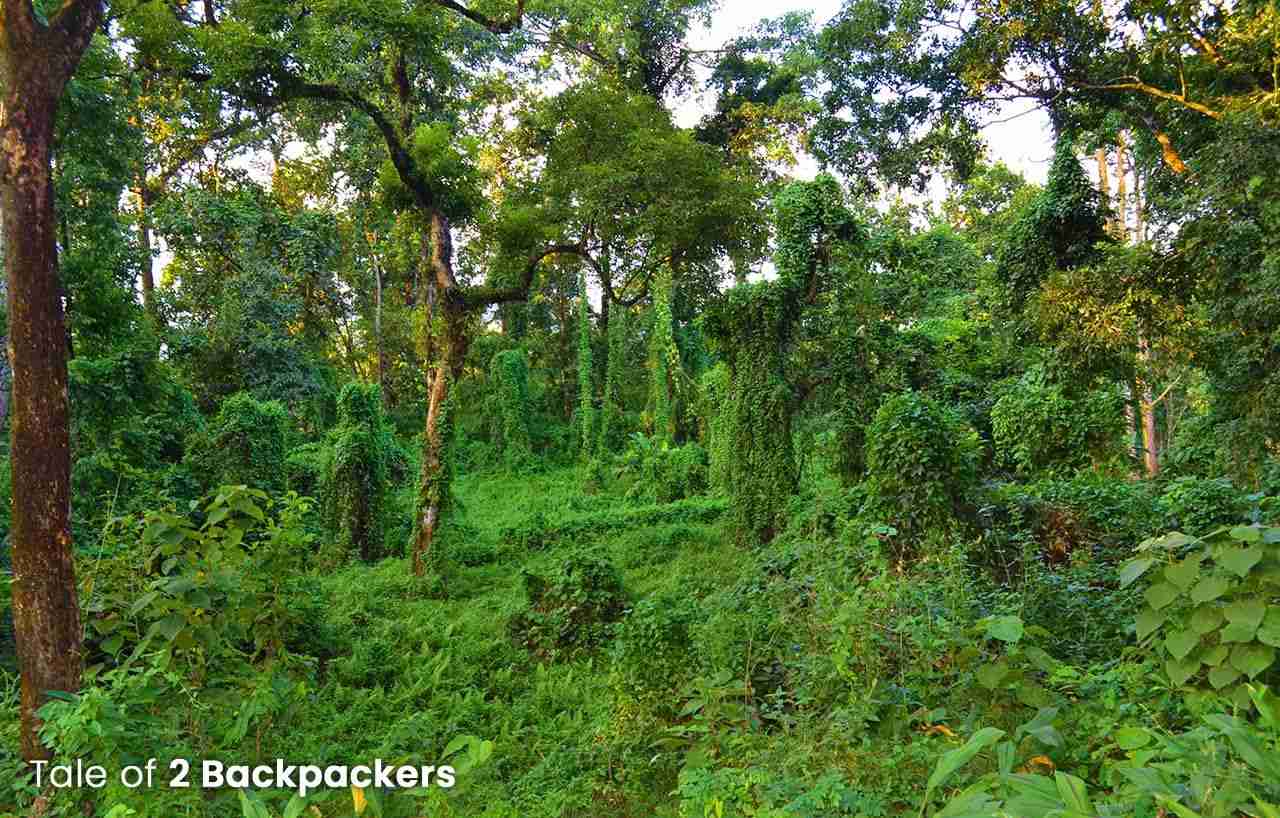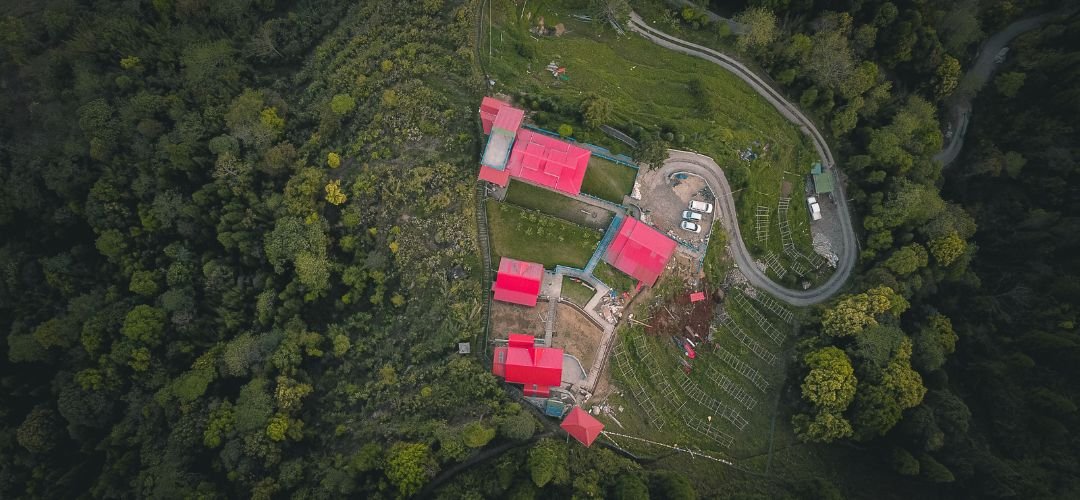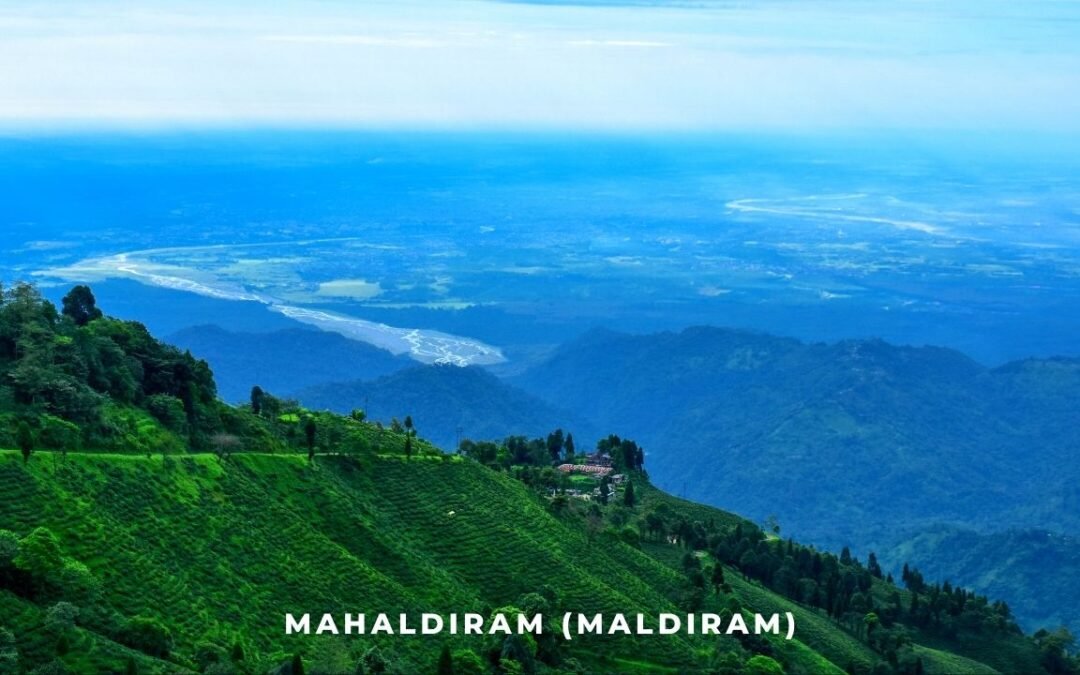Buxa, Jayanti and Lepchakha hold a very special place in our hearts. This trip to Buxa Tiger Reserve and Jayanti was our first trip to Dooars as well as North Bengal. We had visited these places even before we had explored Darjeeling. The Buxa Fort Trek was also our first introduction to the magical world of hiking and trekking.
Buxa is one of the most popular destinations of the Dooars region. The place is a part of the Buxa Tiger Reserve in the Jalpaiguri district of Bengal. The entire region is the part of the Buxa Tiger Reserve, one of the largest forested areas in Dooars. The place is also famous for the short uphill trek route to the historic Buxa Fort. Lepchakha is a small hamlet located on the hilltop and can be reached following the same trail taking to the Buxa Fort.

Buxa Tiger Reserve
Buxa Tiger Reserve is located in the northeastern part of West Bengal bordering Bhutan. It has the largest forest area in the Dooars region covering an area of 759 sq km. The northern part of Buxa Tiger Reserve extends to the Phipsu Wildlife Sanctuary of Bhutan just like the Manas National Park in Assam. This reserve area serves as an important elephant corridor between the forests of Bengal and Bhutan. Located on the foothills of the Lower Himalayas, the landscape of Buxa Tiger Reserve varies to a large extent.
The forest was declared as a Tiger Reserve in 1983. The number of tigers in Buxa Tiger Reserve was once found to be the second largest in West Bengal after Sunderbans. Today, however, the number of tigers is dwindling. Infact, some of the local residents of the area are of the opinion that there are hardly any tigers left at Buxa Tiger Reserve. We, for sure, do not know the actual fact. But we have never heard that any tourists have spotted tigers at Buxa.
The entry point of Buxa Tiger Reserve is at Rajabhatkhawa. When I heard the name first, I found it quite funny. If you translate it in Bengali, it literally means ‘the king ate rice’. Well, actually there is interesting folklore about this place. It is believed that the King of Coochbehar would visit the forests for royal picnics. Obviously, he would have his meals here, and hence Rajabhatkhawa became the name of the place.
There is a ticket counter at Rakabhatkhawa at the entrance of the Buxa Tiger Reserve from where you will get the tickets to enter the reserve area. After entering, a drive of about 10 km will bring you to a crossing known as the Buxa More. The road straight ahead will take you to Santalabari, the foothill. From Santalabari, an uphill trek route takes to the famous Buxa Fort. The trekking trail, if further continued will take you to Lepchakha and another one to Sinchula Pass in Bhutan.
A right turn will take you to Jayanti, a small and beautiful settlement beside Jayanti River. Jayanti is also a part of the Buxa Tiger Reserve and is about 5 km from Buxa More.

Animals at Buxa Tiger Reserve
Tigers are quite rare at Buxa Tiger Reserve and I think sighting them would be a miracle. However other wild animals like the leopards, elephants, bison, spotted deer, barking deer, sambar and hog deer, jackals, hyenas and several other wild cats are found in abundance in the forest. Our forest guide told us that he had spotted leopards quite many times. But he was never lucky to spot a tiger till then! Animals are seen in abundance. Infact, the road from Rajabhatkhawa to Buxa More serves as an elephant corridor. A number of snakes including poisonous ones are also found in the forests of Buxa Tiger Reserve.
The forests of Buxa Tiger Reserve and the nearby villages are also the home to a large number of birds. Migratory birds like Common Teal, Gargani Teal, Large Whistling Teal, White-Eyed Poachared and others also make the area there home during the winters. Many birds can be seen on the banks of Jayanti and Raidak Rivers as well.
Jungle Safari at Buxa Tiger Reserve
Now that you are visiting a forest area, you would want to go for a jungle safari! Jungle safaris at Buxa Tiger Reserve start from Jayanti itself. The safari permits and guides are available at the Jayanti Range Office near the main market area. Here, you can even use your own car for the jungle safari. Otherwise, Gypsy vehicles are also available for booking. Local guides are also available for jungle safari who are quite knowledgeable about the area.

Jeep Safari at Buxa
There are a few jungle trails where the jeep can go involving about 17 km in total. The entry gate for the jeep safari is located near the main market area in Jayanti. Once you enter the forest area you will drive through the dusty jungle trail with thick foliage of trees all around. You might see a few deer, bison and elephants if you are lucky enough.
Jungle safaris are always a great experience even if you do not spot animals. The eerie silence amidst the trees, the grasslands and the lucky sighting of wildlife make them quite enjoyable. In the case of Buxa Tiger Reserve, we could hear only the incessant sound of crickets. We spotted a few deer and bison and some birds inside the jungle. Later we went beside the Bala River and then returned back.
Safari Timings:
6.00 am to 11.00 am and 2.00 pm to 5.00 pm
Only a limited number of vehicles are allowed for jungle safari inside the Buxa Tiger Reserve. On spot booking during the tourist season becomes a bit difficult. So night stay at Jayanti is recommended.
Cost of Jeep Safari: If you book the entire Jeep along with the guide, it might cost you around Rs.1200.00 (as of October 2019). It includes permits and guide fees.

Chunia Watchtower Safari
Chunia Watchtower and the Bhutia Basti Watchtower lie across the Jayanti River on the opposite side of the Jayanti village. Both the watchtowers fall in the buffer zone of the Buxa Tiger Reserve. You can book a jeep safari from the Jayanti Range Office to the forest area where Chunia Watchtower is located. This forest is known as the Chunia Forests. From the watchtower, you can spot a number of wildlife like the elephants, bison and various types of deer. Elephants can also be spotted many times. You have to cross the Jayanti River bed on the jeep to the other side for this safari. I think this is the most exciting part of the safari.
Trek to the Pokhri Hill

Pokhri Hill is located about 4 km from Jayanti and you can take your car up to the base of the hill. Pokhri means pond and the name comes because of the presence of a pond on the hill. From the base, there is a trekking route of about 1.5 km through the dense forests. Taking a guide with you is a must for trekking to the Pokhri Hill. The jungle is dense and there might be a number of ways inside the forests.
There is a small lake in the midst of the forest area. The lake is considered to be quite sacred among the Buddhists and local community. There are a number of fishes and turtles inside the lake and you can feed them. Guide charge for the trek to Pokhri Hills is Rs 250.00.
Jayanti
The best part of our Buxa Jayanti trip was definitely our visit to Jayanti. The small village settlement inside Buxa Tiger Reserve is developed beside the Jayanti River. Jayanti is given the name of “Queen of Dooars”. After our visit to Jayanti, we totally agree on the given moniker. For Jayanti is simply beautiful. The small village, the riverside, the quaint houses and everything about Jayanti is lovely. But the most gorgeous is the Jayanti River.

Infact, Jayanti River is the main attraction of this small village. You will hardly find water in the river other than the monsoon season. The riverbed is full of loose stones and boulders with a narrow stream of water flowing in the middle. Just opposite the river, you can see the Bhutan hills and the forests. These forests are the extended part of the Buxa Tiger Reserve. The riverbed looks white and pristine and at the backdrop of the hills and forests, the meandering river looks just mesmerizing.
There is a broken bridge-like structure in the middle of the river. It seems there used to be an iron bridge there once upon a time. The entire place looks so romantic and lovely.
Even during the evening, the river looks mesmerizing. We would always remember the time spent at the banks of the Jayanti River. We simply sat there talking to each other and did not know where the time went by. We also walked on the riverbed, went near the broken bridge and spent some memorable moments there. The mornings are equally beautiful at Jayanti. We had seen many breathtaking sunrises at Sandakphu-Phalut and at Tiger Hill before. The sunrise at Jayanti was also special and extremely beautiful.

Jayanti is located about 5 km from Buxa More. On the way to Jayanti, you have to cross the Bala River. There used to be a bridge here once upon a time, but now no more. The river remains dry most of the time except the monsoon and you can easily drive across it. But during monsoons, when the Bala River swells, Jayanti often gets cut-off from Buxa.
Jayanti has a small market area. There are about 38 villages in the entire Buxa Tiger Reserve area and Jayanti is one of them. Recently, eco-tourism has been developed here and tourism is proving to be a mode of income for the villagers in Jayanti. Many homestays are developed and many villagers are getting trained as guides for the wildlife safari at Buxa Tiger Reserve.
Mahakal Trek
Mahakal is located along the Jayanti River and is another great Dooars trek. Mahakal Cave is located about 13 km from Jayanti and the caves are dedicated to Lord Shiva. The trek route to Mahakal cave is through the dense forests inside the Buxa Tiger Reserve. The best time for the trek is during the winter season when the river is dry. During the monsoon the trek route becomes inaccessible.
Our Experience at Buxa Jayanti
We had visited Buxa and Jayanti while on our tour to Dooars. After our visit to Rongo, Jaldhaka and Lataguri, we were finally at Buxa. As I mentioned earlier, Jayanti was definitely the highlight of our trip. Here I will give the itinerary for Buxa Jayanti trip that we had followed. This might help you in planning your trip.
Buxa Tiger Reserve and Jayanti Tentative Itinerary
Day 1: Lataguri – Jayanti

We visited Buxa after our visit to Lataguri. We had hired a car for the entire Dooars trip. We started from Lataguri and arrived at Rajabhatkhawa by 10.00 am. We got our entry tickets for the car and ourselves and entered into the Buxa Tiger Reserve.
The road was quite good – pitch black and with thick forests at both sides. The continuous sound of crickets was the only sound that we could hear. Very soon we were at the Buxa More. We took the right and headed towards Jayanti.
The first thing we did was to book a safari the next day. The entire day, we spent near the Jayanti River. In the afternoon, we trekked to the Pokhri Hill and the evening was again spent by the Jayanti River.
Day 2: Jayanti

We went for an early morning safari inside the Buxa Tiger Reserve. Later in the day, we crossed the Jayanti River and visited the Chunia Watchtower on the other side. The rest of the day we spent exploring the village and by the Jayanti River.
Day 3: Jayanti – Buxa Fort – Lepchakha – Buxa Sadar Village
We started from Jayanti early in the morning and reached Santalabari, kept our car near the Government office there, took our bags and started our trek. To be honest, Buxa trek was our introduction to the world of trekking. We had initially thought that we would trek up to the Buxa Fort and come down again and go to Jayanti on the same day itself. But we did not know that we would be so tired after we reached Buxa Fort.

We started our trek and reached the Buxa Fort after 2 hours of huffing and puffing. After reaching Buxa Fort, we spent some time there and then checked into a homestay, Later in the afternoon, we trekked to Lepchakha, the Drukpa village on the hilltop. Lepchakha is a beautiful place. We wished we had more time as we wanted to stay back in the beautiful village. But after watching the glorious sunset, we had to trek back to Buxa Fort. You will get the details of our Buxa Fort Trek and Lepchakha in the other article. We stayed back at Buxa Fort that day.
Day 4: Buxa Village – Rakabhatkhawa – New Alipurduar
We started late in the morning and came down to Santalabari. From there, we took our car and started towards New Alipurduar Railway Station to catch our train back to Kolkata.

How to reach Buxa Tiger Reserve and Jayanti?
The nearest Railway Station is New Alipurduar, about 15 km from Rajabhatkhawa. You can get a taxi or auto from New Alipurduar to Rajabhatkhawa. It will take about 15 minutes to reach there from the railway station. Jayanti is another 15 km from the entry gate. Buses ply from Jayanti to Rajabhatkhawa, but the timings are a bit erratic. It is better not to wait for buses when you are going towards Jayanti. During the return to Rajabhatkhawa, you can try for the buses.
The nearest airport is at Bagdogra, 180 km from Rajabhatkhawa. New Jalpaiguri is about 176 km from Rajabhatkhawa. You can hire a car from NJP or Bagdogra to reach Rajabhatkhawa or Jayanti.
There is a small railway station at Rajabhatkhawa as well. But no express train stops at this station. There are a few passenger trains running from Siliguri to Alipurduar that stops at Rajabhatkhawa.

Where to stay at Jayanti?
There are a number of homestays and lodges at Jayanti. West Bengal Forest Development Corporation (WBFDC) has a lodge at Rajabhatkhawa. You can book the Rajabhatkhawa Buxa Jungle Lodge online.
If you prefer to stay at Jayanti, then there are a number of private lodges there. Here are a few of them with contact numbers:
Banante : +91 9609931857 / 9230543807
Rover’s Inn: +91 9434014233 / 9434754349

What is the best time to visit Buxa Tiger Reserve and Jayanti?
The best time to visit Buxa Tiger Reserve and Jayanti is between December to February. The weather remains cool in the morning and cold at night. Wildlife safaris are also enjoyable during this time.
June to September is the monsoon season and it rains very heavily during this time. Buxa Tiger Reserve remains closed between mid-June to mid-September. Jayanti often becomes inaccessible during this time.
Another good time to visit is during October and November. The weather remains cool, but the wildlife sighting becomes a bit poor due to post-monsoon growth.
You can also visit between March to May, but be prepared for a hot and humid climate. The days will be scorching and I don’t think even spending time beside the Jayanti River will be enjoyed during this time.
Did you like the post? Please let us know in comments below. Also share your experience of the visit to Buxa Tiger Reserve, Buxa Fort and Jayanti with us.
Share the love…









0 Comments